Refine search
No keyword found to refine search
keywords EN
Places
Names
775 documents found
| 1 | 13 |
Documents per page :

Animals in nursing homes
Michael Bunel / Le Pictorium
LePictorium_0287712.jpg
Jeanine (95), Madeleine (95) and Roger (98) with the two donkeys, Manon and Ginette, who spontaneously made their way to the residents. An amendment to the "ageing well" law, scheduled for final adoption in 2024, obliges senior citizen facilities to admit residents' pets... December 27, 2023. Bourron marlotte. France

Animals in nursing homes
Michael Bunel / Le Pictorium
LePictorium_0287713.jpg
A resident sleeps in his wheelchair. Next to him are two parakeets in their cages. They are one of the establishment's animals, along with two rabbits, two goats, two donkeys and two cats. An amendment to the "ageing well" law, scheduled for final adoption in 2024, obliges establishments for the elderly to admit residents' pets.December 27, 2023. Bourron marlotte. France

Animals in nursing homes
Michael Bunel / Le Pictorium
LePictorium_0287714.jpg
Animal therapy sessions with residents. The sessions feature a range of games to stimulate memory, communication, touch, vision and social interaction. Sessions take place once a week. An amendment to the "ageing well" law, scheduled for final adoption in 2024, will oblige senior citizen facilities to admit residents' pets.December 27, 2023. Bourron marlotte. France

Animals in nursing homes
Michael Bunel / Le Pictorium
LePictorium_0287715.jpg
Animal therapy sessions with residents. The sessions feature a range of games to stimulate memory, communication, touch, vision and social interaction. Sessions take place once a week. An amendment to the "ageing well" law, scheduled for final adoption in 2024, will oblige senior citizen facilities to admit residents' pets.December 27, 2023. Bourron marlotte. France

Animals in nursing homes
Michael Bunel / Le Pictorium
LePictorium_0287716.jpg
Animal therapy sessions with residents. The sessions feature a range of games to stimulate memory, communication, touch, vision and social interaction. Sessions take place once a week. An amendment to the "ageing well" law, scheduled for final adoption in 2024, will oblige senior citizen facilities to admit residents' pets.December 27, 2023. Bourron marlotte. France
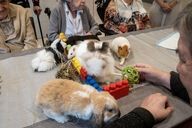
Animals in nursing homes
Michael Bunel / Le Pictorium
LePictorium_0287717.jpg
Animal therapy sessions with residents. The sessions feature a range of games to stimulate memory, communication, touch, vision and social interaction. Sessions take place once a week. An amendment to the "ageing well" law, scheduled for final adoption in 2024, will oblige senior citizen facilities to admit residents' pets.December 27, 2023. Bourron marlotte. France
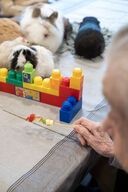
Animals in nursing homes
Michael Bunel / Le Pictorium
LePictorium_0287718.jpg
During a pet therapy session, a resident hands out food to animals. During the sessions, several games are played to stimulate memories, communication, touch, vision and social interaction. Sessions are held once a week. An amendment to the "ageing well" law, scheduled for final adoption in 2024, obliges retirement homes to admit residents' pets. December 27, 2023. Bourron marlotte. France
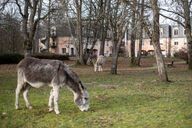
Animals in nursing homes
Michael Bunel / Le Pictorium
LePictorium_0287719.jpg
The two donkeys, Ginette and Manon, in the residence grounds. The retirement home is unique in that it accepts residents with their pets. The residence also has animals such as these two donkeys, as well as cats, goats, parakeets and rabbits. An amendment to the "ageing well" law, due for final adoption in 2024, obliges retirement homes to admit residents' pets. December 27, 2023. Bourron marlotte. France
Translated with www.DeepL.com/Translator (free version)
Translated with www.DeepL.com/Translator (free version)
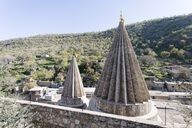
Lalish
Gabriel Gauffre / Le Pictorium
LePictorium_0282186.jpg
View of the Lalish temples.
Lalish, located in the heart of Iraqi Kurdistan, is the most sacred site to the Yazidi. They must make the pilgrimage there at least once in their life, for six days, in order to pay their respects to Sheikh Adi ibn Musafir’s tomb, the founder of the religion. They are about 700 000 in Iraq. Founded in the 12th century, the religion mixes elements of Islam with local pre-Islamic beliefs, making them a major target during the expansion of the Islamic state in Iraq.
Lalish, located in the heart of Iraqi Kurdistan, is the most sacred site to the Yazidi. They must make the pilgrimage there at least once in their life, for six days, in order to pay their respects to Sheikh Adi ibn Musafir’s tomb, the founder of the religion. They are about 700 000 in Iraq. Founded in the 12th century, the religion mixes elements of Islam with local pre-Islamic beliefs, making them a major target during the expansion of the Islamic state in Iraq.
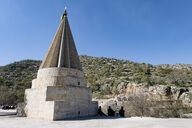
Lalish
Gabriel Gauffre / Le Pictorium
LePictorium_0282187.jpg
View of the Lalish temples.
Lalish, located in the heart of Iraqi Kurdistan, is the most sacred site to the Yazidi. They must make the pilgrimage there at least once in their life, for six days, in order to pay their respects to Sheikh Adi ibn Musafir’s tomb, the founder of the religion. They are about 700 000 in Iraq. Founded in the 12th century, the religion mixes elements of Islam with local pre-Islamic beliefs, making them a major target during the expansion of the Islamic state in Iraq.
Lalish, located in the heart of Iraqi Kurdistan, is the most sacred site to the Yazidi. They must make the pilgrimage there at least once in their life, for six days, in order to pay their respects to Sheikh Adi ibn Musafir’s tomb, the founder of the religion. They are about 700 000 in Iraq. Founded in the 12th century, the religion mixes elements of Islam with local pre-Islamic beliefs, making them a major target during the expansion of the Islamic state in Iraq.
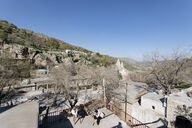
Lalish
Gabriel Gauffre / Le Pictorium
LePictorium_0282188.jpg
View of the Lalish temples.
Lalish, located in the heart of Iraqi Kurdistan, is the most sacred site to the Yazidi. They must make the pilgrimage there at least once in their life, for six days, in order to pay their respects to Sheikh Adi ibn Musafir’s tomb, the founder of the religion. They are about 700 000 in Iraq. Founded in the 12th century, the religion mixes elements of Islam with local pre-Islamic beliefs, making them a major target during the expansion of the Islamic state in Iraq.
Lalish, located in the heart of Iraqi Kurdistan, is the most sacred site to the Yazidi. They must make the pilgrimage there at least once in their life, for six days, in order to pay their respects to Sheikh Adi ibn Musafir’s tomb, the founder of the religion. They are about 700 000 in Iraq. Founded in the 12th century, the religion mixes elements of Islam with local pre-Islamic beliefs, making them a major target during the expansion of the Islamic state in Iraq.
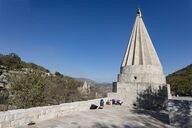
Lalish
Gabriel Gauffre / Le Pictorium
LePictorium_0282189.jpg
View of the Lalish temples.
Lalish, located in the heart of Iraqi Kurdistan, is the most sacred site to the Yazidi. They must make the pilgrimage there at least once in their life, for six days, in order to pay their respects to Sheikh Adi ibn Musafir’s tomb, the founder of the religion. They are about 700 000 in Iraq. Founded in the 12th century, the religion mixes elements of Islam with local pre-Islamic beliefs, making them a major target during the expansion of the Islamic state in Iraq.
Lalish, located in the heart of Iraqi Kurdistan, is the most sacred site to the Yazidi. They must make the pilgrimage there at least once in their life, for six days, in order to pay their respects to Sheikh Adi ibn Musafir’s tomb, the founder of the religion. They are about 700 000 in Iraq. Founded in the 12th century, the religion mixes elements of Islam with local pre-Islamic beliefs, making them a major target during the expansion of the Islamic state in Iraq.
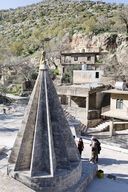
Lalish
Gabriel Gauffre / Le Pictorium
LePictorium_0282190.jpg
View of the Lalish temples.
Lalish, located in the heart of Iraqi Kurdistan, is the most sacred site to the Yazidi. They must make the pilgrimage there at least once in their life, for six days, in order to pay their respects to Sheikh Adi ibn Musafir’s tomb, the founder of the religion. They are about 700 000 in Iraq. Founded in the 12th century, the religion mixes elements of Islam with local pre-Islamic beliefs, making them a major target during the expansion of the Islamic state in Iraq.
Lalish, located in the heart of Iraqi Kurdistan, is the most sacred site to the Yazidi. They must make the pilgrimage there at least once in their life, for six days, in order to pay their respects to Sheikh Adi ibn Musafir’s tomb, the founder of the religion. They are about 700 000 in Iraq. Founded in the 12th century, the religion mixes elements of Islam with local pre-Islamic beliefs, making them a major target during the expansion of the Islamic state in Iraq.
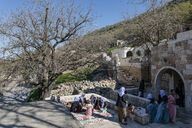
Lalish
Gabriel Gauffre / Le Pictorium
LePictorium_0282191.jpg
The faithful rest during a pilgrimage.
Lalish, located in the heart of Iraqi Kurdistan, is the most sacred site to the Yazidi. They must make the pilgrimage there at least once in their life, for six days, in order to pay their respects to Sheikh Adi ibn Musafir’s tomb, the founder of the religion. They are about 700 000 in Iraq. Founded in the 12th century, the religion mixes elements of Islam with local pre-Islamic beliefs, making them a major target during the expansion of the Islamic state in Iraq.
Lalish, located in the heart of Iraqi Kurdistan, is the most sacred site to the Yazidi. They must make the pilgrimage there at least once in their life, for six days, in order to pay their respects to Sheikh Adi ibn Musafir’s tomb, the founder of the religion. They are about 700 000 in Iraq. Founded in the 12th century, the religion mixes elements of Islam with local pre-Islamic beliefs, making them a major target during the expansion of the Islamic state in Iraq.
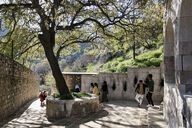
Lalish
Gabriel Gauffre / Le Pictorium
LePictorium_0282192.jpg
Pilgrims in Lalish.
Lalish, located in the heart of Iraqi Kurdistan, is the most sacred site to the Yazidi. They must make the pilgrimage there at least once in their life, for six days, in order to pay their respects to Sheikh Adi ibn Musafir’s tomb, the founder of the religion. They are about 700 000 in Iraq. Founded in the 12th century, the religion mixes elements of Islam with local pre-Islamic beliefs, making them a major target during the expansion of the Islamic state in Iraq.
Lalish, located in the heart of Iraqi Kurdistan, is the most sacred site to the Yazidi. They must make the pilgrimage there at least once in their life, for six days, in order to pay their respects to Sheikh Adi ibn Musafir’s tomb, the founder of the religion. They are about 700 000 in Iraq. Founded in the 12th century, the religion mixes elements of Islam with local pre-Islamic beliefs, making them a major target during the expansion of the Islamic state in Iraq.

Lalish
Gabriel Gauffre / Le Pictorium
LePictorium_0282193.jpg
View of the Lalish temples.
Lalish, located in the heart of Iraqi Kurdistan, is the most sacred site to the Yazidi. They must make the pilgrimage there at least once in their life, for six days, in order to pay their respects to Sheikh Adi ibn Musafir’s tomb, the founder of the religion. They are about 700 000 in Iraq. Founded in the 12th century, the religion mixes elements of Islam with local pre-Islamic beliefs, making them a major target during the expansion of the Islamic state in Iraq.
Lalish, located in the heart of Iraqi Kurdistan, is the most sacred site to the Yazidi. They must make the pilgrimage there at least once in their life, for six days, in order to pay their respects to Sheikh Adi ibn Musafir’s tomb, the founder of the religion. They are about 700 000 in Iraq. Founded in the 12th century, the religion mixes elements of Islam with local pre-Islamic beliefs, making them a major target during the expansion of the Islamic state in Iraq.
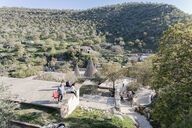
Lalish
Gabriel Gauffre / Le Pictorium
LePictorium_0282194.jpg
View of the Lalish temples.
Lalish, located in the heart of Iraqi Kurdistan, is the most sacred site to the Yazidi. They must make the pilgrimage there at least once in their life, for six days, in order to pay their respects to Sheikh Adi ibn Musafir’s tomb, the founder of the religion. They are about 700 000 in Iraq. Founded in the 12th century, the religion mixes elements of Islam with local pre-Islamic beliefs, making them a major target during the expansion of the Islamic state in Iraq.
Lalish, located in the heart of Iraqi Kurdistan, is the most sacred site to the Yazidi. They must make the pilgrimage there at least once in their life, for six days, in order to pay their respects to Sheikh Adi ibn Musafir’s tomb, the founder of the religion. They are about 700 000 in Iraq. Founded in the 12th century, the religion mixes elements of Islam with local pre-Islamic beliefs, making them a major target during the expansion of the Islamic state in Iraq.
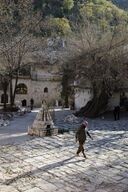
Lalish
Gabriel Gauffre / Le Pictorium
LePictorium_0282195.jpg
View of the Lalish temples.
Lalish, located in the heart of Iraqi Kurdistan, is the most sacred site to the Yazidi. They must make the pilgrimage there at least once in their life, for six days, in order to pay their respects to Sheikh Adi ibn Musafir’s tomb, the founder of the religion. They are about 700 000 in Iraq. Founded in the 12th century, the religion mixes elements of Islam with local pre-Islamic beliefs, making them a major target during the expansion of the Islamic state in Iraq.
Lalish, located in the heart of Iraqi Kurdistan, is the most sacred site to the Yazidi. They must make the pilgrimage there at least once in their life, for six days, in order to pay their respects to Sheikh Adi ibn Musafir’s tomb, the founder of the religion. They are about 700 000 in Iraq. Founded in the 12th century, the religion mixes elements of Islam with local pre-Islamic beliefs, making them a major target during the expansion of the Islamic state in Iraq.
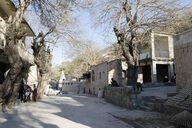
Lalish
Gabriel Gauffre / Le Pictorium
LePictorium_0282196.jpg
The main street of the Lalish religious complex.
Lalish, located in the heart of Iraqi Kurdistan, is the most sacred site to the Yazidi. They must make the pilgrimage there at least once in their life, for six days, in order to pay their respects to Sheikh Adi ibn Musafir’s tomb, the founder of the religion. They are about 700 000 in Iraq. Founded in the 12th century, the religion mixes elements of Islam with local pre-Islamic beliefs, making them a major target during the expansion of the Islamic state in Iraq.
Lalish, located in the heart of Iraqi Kurdistan, is the most sacred site to the Yazidi. They must make the pilgrimage there at least once in their life, for six days, in order to pay their respects to Sheikh Adi ibn Musafir’s tomb, the founder of the religion. They are about 700 000 in Iraq. Founded in the 12th century, the religion mixes elements of Islam with local pre-Islamic beliefs, making them a major target during the expansion of the Islamic state in Iraq.
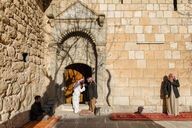
Lalish
Gabriel Gauffre / Le Pictorium
LePictorium_0282197.jpg
Pilgrims in Lalish.
Lalish, located in the heart of Iraqi Kurdistan, is the most sacred site to the Yazidi. They must make the pilgrimage there at least once in their life, for six days, in order to pay their respects to Sheikh Adi ibn Musafir’s tomb, the founder of the religion. They are about 700 000 in Iraq. Founded in the 12th century, the religion mixes elements of Islam with local pre-Islamic beliefs, making them a major target during the expansion of the Islamic state in Iraq.
Lalish, located in the heart of Iraqi Kurdistan, is the most sacred site to the Yazidi. They must make the pilgrimage there at least once in their life, for six days, in order to pay their respects to Sheikh Adi ibn Musafir’s tomb, the founder of the religion. They are about 700 000 in Iraq. Founded in the 12th century, the religion mixes elements of Islam with local pre-Islamic beliefs, making them a major target during the expansion of the Islamic state in Iraq.
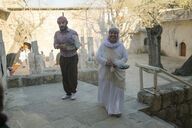
Lalish
Gabriel Gauffre / Le Pictorium
LePictorium_0282198.jpg
A priestess during a ceremony in Lalish.
Lalish, located in the heart of Iraqi Kurdistan, is the most sacred site to the Yazidi. They must make the pilgrimage there at least once in their life, for six days, in order to pay their respects to Sheikh Adi ibn Musafir’s tomb, the founder of the religion. They are about 700 000 in Iraq. Founded in the 12th century, the religion mixes elements of Islam with local pre-Islamic beliefs, making them a major target during the expansion of the Islamic state in Iraq.
Lalish, located in the heart of Iraqi Kurdistan, is the most sacred site to the Yazidi. They must make the pilgrimage there at least once in their life, for six days, in order to pay their respects to Sheikh Adi ibn Musafir’s tomb, the founder of the religion. They are about 700 000 in Iraq. Founded in the 12th century, the religion mixes elements of Islam with local pre-Islamic beliefs, making them a major target during the expansion of the Islamic state in Iraq.
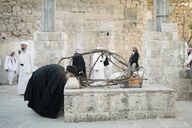
Lalish
Gabriel Gauffre / Le Pictorium
LePictorium_0282199.jpg
Lalish, located in the heart of Iraqi Kurdistan, is the most sacred site to the Yazidi. They must make the pilgrimage there at least once in their life, for six days, in order to pay their respects to Sheikh Adi ibn Musafir’s tomb, the founder of the religion. They are about 700 000 in Iraq. Founded in the 12th century, the religion mixes elements of Islam with local pre-Islamic beliefs, making them a major target during the expansion of the Islamic state in Iraq.
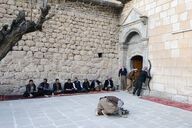
Lalish
Gabriel Gauffre / Le Pictorium
LePictorium_0282200.jpg
A pilgrim kisses a sacred stone in Lalish.
Lalish, located in the heart of Iraqi Kurdistan, is the most sacred site to the Yazidi. They must make the pilgrimage there at least once in their life, for six days, in order to pay their respects to Sheikh Adi ibn Musafir’s tomb, the founder of the religion. They are about 700 000 in Iraq. Founded in the 12th century, the religion mixes elements of Islam with local pre-Islamic beliefs, making them a major target during the expansion of the Islamic state in Iraq.
Lalish, located in the heart of Iraqi Kurdistan, is the most sacred site to the Yazidi. They must make the pilgrimage there at least once in their life, for six days, in order to pay their respects to Sheikh Adi ibn Musafir’s tomb, the founder of the religion. They are about 700 000 in Iraq. Founded in the 12th century, the religion mixes elements of Islam with local pre-Islamic beliefs, making them a major target during the expansion of the Islamic state in Iraq.
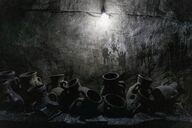
Lalish
Gabriel Gauffre / Le Pictorium
LePictorium_0282201.jpg
The Hesen Dana room, containing the jars filled with the oil used to light the temple's 365 lamps.
Lalish, located in the heart of Iraqi Kurdistan, is the most sacred site to the Yazidi. They must make the pilgrimage there at least once in their life, for six days, in order to pay their respects to Sheikh Adi ibn Musafir’s tomb, the founder of the religion. They are about 700 000 in Iraq. Founded in the 12th century, the religion mixes elements of Islam with local pre-Islamic beliefs, making them a major target during the expansion of the Islamic state in Iraq.
Lalish, located in the heart of Iraqi Kurdistan, is the most sacred site to the Yazidi. They must make the pilgrimage there at least once in their life, for six days, in order to pay their respects to Sheikh Adi ibn Musafir’s tomb, the founder of the religion. They are about 700 000 in Iraq. Founded in the 12th century, the religion mixes elements of Islam with local pre-Islamic beliefs, making them a major target during the expansion of the Islamic state in Iraq.
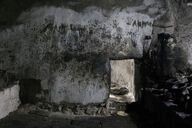
Lalish
Gabriel Gauffre / Le Pictorium
LePictorium_0282202.jpg
The Hesen Dana room, containing the jars filled with the oil used to light the temple's 365 lamps.
Lalish, located in the heart of Iraqi Kurdistan, is the most sacred site to the Yazidi. They must make the pilgrimage there at least once in their life, for six days, in order to pay their respects to Sheikh Adi ibn Musafir’s tomb, the founder of the religion. They are about 700 000 in Iraq. Founded in the 12th century, the religion mixes elements of Islam with local pre-Islamic beliefs, making them a major target during the expansion of the Islamic state in Iraq.
Lalish, located in the heart of Iraqi Kurdistan, is the most sacred site to the Yazidi. They must make the pilgrimage there at least once in their life, for six days, in order to pay their respects to Sheikh Adi ibn Musafir’s tomb, the founder of the religion. They are about 700 000 in Iraq. Founded in the 12th century, the religion mixes elements of Islam with local pre-Islamic beliefs, making them a major target during the expansion of the Islamic state in Iraq.
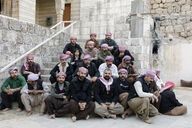
Lalish
Gabriel Gauffre / Le Pictorium
LePictorium_0282203.jpg
A group of Yezidi men in the temple's central courtyard.
Lalish, located in the heart of Iraqi Kurdistan, is the most sacred site to the Yazidi. They must make the pilgrimage there at least once in their life, for six days, in order to pay their respects to Sheikh Adi ibn Musafir’s tomb, the founder of the religion. They are about 700 000 in Iraq. Founded in the 12th century, the religion mixes elements of Islam with local pre-Islamic beliefs, making them a major target during the expansion of the Islamic state in Iraq.
Lalish, located in the heart of Iraqi Kurdistan, is the most sacred site to the Yazidi. They must make the pilgrimage there at least once in their life, for six days, in order to pay their respects to Sheikh Adi ibn Musafir’s tomb, the founder of the religion. They are about 700 000 in Iraq. Founded in the 12th century, the religion mixes elements of Islam with local pre-Islamic beliefs, making them a major target during the expansion of the Islamic state in Iraq.
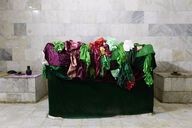
Lalish
Gabriel Gauffre / Le Pictorium
LePictorium_0282204.jpg
The tomb of Sheikh Adi ibn Musafir.
Lalish, located in the heart of Iraqi Kurdistan, is the most sacred site to the Yazidi. They must make the pilgrimage there at least once in their life, for six days, in order to pay their respects to Sheikh Adi ibn Musafir’s tomb, the founder of the religion. They are about 700 000 in Iraq. Founded in the 12th century, the religion mixes elements of Islam with local pre-Islamic beliefs, making them a major target during the expansion of the Islamic state in Iraq.
Lalish, located in the heart of Iraqi Kurdistan, is the most sacred site to the Yazidi. They must make the pilgrimage there at least once in their life, for six days, in order to pay their respects to Sheikh Adi ibn Musafir’s tomb, the founder of the religion. They are about 700 000 in Iraq. Founded in the 12th century, the religion mixes elements of Islam with local pre-Islamic beliefs, making them a major target during the expansion of the Islamic state in Iraq.

Demonstration against the pension reform in Paris
Michael Bunel / Le Pictorium
LePictorium_0276540.jpg
A demonstrator holds up a sign inspired by the game "le mille borne". 60 max is written in a red circle. The seventh day of mobilisation against the pension reform and the modification of the retirement age. The demonstration gathered 368,000 demonstrators everywhere in France, including 48,000 in Paris, according to the Ministry of the Interior. The CGT counted more than one million demonstrators, including 300,000 in Paris. 11 March 2023. Paris, France.

Strike against the pension reform in Paris
Jan Schmidt-Whitley/Le Pictorium
LePictorium_0273635.jpg
Many high school students, students and young people were mobilized in the procession. In Paris, the different left-wing parties members of the Nupes marched together behind the inter-union, which called for a strike on Thursday 19 January against the government's reform. If the Parisian demonstration was marred by some minor incidents, the day of mobilisation took place in a calm atmosphere. The Ministry of the Interior counted 1.12 million demonstrators across the country. According to the ministry, some 80,000 people marched in the streets of Paris. The CGT had said that "more than two million" people had demonstrated in France on Thursday.
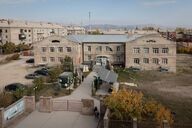
Armenia - Rebuilding after the war
Chris Huby / Le Pictorium
LePictorium_0272890.jpg
Armenia - Gyumri / Overview of Endanik.
The charitable NGO "Endanik" was founded in 1990 and was one of the first in Gyumri after the earthquake to deal with the basic problems of adolescents. Since the Azeri attacks at the end of 2020, the centre has been dealing with displaced persons and orphans
The charitable NGO "Endanik" was founded in 1990 and was one of the first in Gyumri after the earthquake to deal with the basic problems of adolescents. Since the Azeri attacks at the end of 2020, the centre has been dealing with displaced persons and orphans

Armenia - Rebuilding after the war
Chris Huby / Le Pictorium
LePictorium_0272891.jpg
Armenia - Gyumri / Endanik entrance.
The charitable NGO "Endanik" was founded in 1990 and was one of the first in Gyumri after the earthquake to deal with the basic problems of adolescents. Since the Azeri attacks at the end of 2020, the centre has been dealing with displaced persons and orphans
The charitable NGO "Endanik" was founded in 1990 and was one of the first in Gyumri after the earthquake to deal with the basic problems of adolescents. Since the Azeri attacks at the end of 2020, the centre has been dealing with displaced persons and orphans
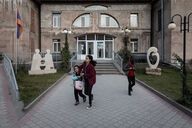
Armenia - Rebuilding after the war
Chris Huby / Le Pictorium
LePictorium_0272892.jpg
Armenia - Gyumri / Endanik entrance.
The charitable NGO "Endanik" was founded in 1990 and was one of the first in Gyumri after the earthquake to deal with the basic problems of adolescents. Since the Azeri attacks at the end of 2020, the centre has been dealing with displaced persons and orphans
The charitable NGO "Endanik" was founded in 1990 and was one of the first in Gyumri after the earthquake to deal with the basic problems of adolescents. Since the Azeri attacks at the end of 2020, the centre has been dealing with displaced persons and orphans
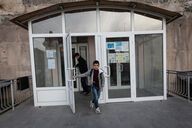
Armenia - Rebuilding after the war
Chris Huby / Le Pictorium
LePictorium_0272893.jpg
Armenia - Gyumri / Endanik entrance.
The charitable NGO "Endanik" was founded in 1990 and was one of the first in Gyumri after the earthquake to deal with the basic problems of adolescents. Since the Azeri attacks at the end of 2020, the centre has been dealing with displaced persons and orphans
The charitable NGO "Endanik" was founded in 1990 and was one of the first in Gyumri after the earthquake to deal with the basic problems of adolescents. Since the Azeri attacks at the end of 2020, the centre has been dealing with displaced persons and orphans
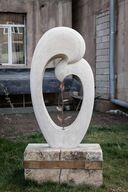
Armenia - Rebuilding after the war
Chris Huby / Le Pictorium
LePictorium_0272894.jpg
Armenia - Gyumri / At the entrance to Endanik, a statue symbolizing the heart- Founded in 1990 after the earthquake, this NGO was one of the first to take care of adolescents in the region. Charitable NGO “Endanik” was founded in 1990 and was one of the first in Gyumri after the earthquake to deal with basic problems of teenagers. Since the Azeri attacks at the end of 2020, the center has been taking care of displaced persons and orphans
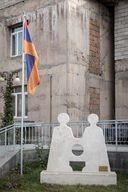
Armenia - Rebuilding after the war
Chris Huby / Le Pictorium
LePictorium_0272895.jpg
Armenia - Gyumri / At the entrance to Endanik, a statue symbolizing the center - Founded in 1990 after the earthquake, this NGO was one of the first to take care of adolescents in the region. Charitable NGO “Endanik” was founded in 1990 and was one of the first in Gyumri after the earthquake to deal with basic problems of teenagers. Since the Azeri attacks at the end of 2020, the center has been taking care of displaced persons and orphans
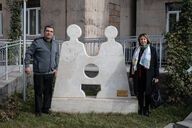
Armenia - Rebuilding after the war
Chris Huby / Le Pictorium
LePictorium_0272896.jpg
Armenia - Gyumri / Endanik - Portrait of the directors of the centre.
The charitable NGO "Endanik" was founded in 1990 and was one of the first in Gyumri after the earthquake to deal with the basic problems of adolescents. Since the Azeri attacks at the end of 2020, the centre has been dealing with displaced persons and orphans
The charitable NGO "Endanik" was founded in 1990 and was one of the first in Gyumri after the earthquake to deal with the basic problems of adolescents. Since the Azeri attacks at the end of 2020, the centre has been dealing with displaced persons and orphans
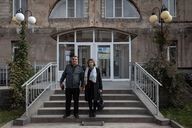
Armenia - Rebuilding after the war
Chris Huby / Le Pictorium
LePictorium_0272897.jpg
Armenia - Gyumri / Endanik - Portrait of the directors of the centre.
The charitable NGO "Endanik" was founded in 1990 and was one of the first in Gyumri after the earthquake to deal with the basic problems of adolescents. Since the Azeri attacks at the end of 2020, the centre has been dealing with displaced persons and orphans
The charitable NGO "Endanik" was founded in 1990 and was one of the first in Gyumri after the earthquake to deal with the basic problems of adolescents. Since the Azeri attacks at the end of 2020, the centre has been dealing with displaced persons and orphans
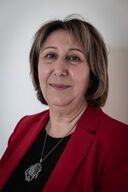
Armenia - Rebuilding after the war
Chris Huby / Le Pictorium
LePictorium_0272898.jpg
Armenia - Gyumri / Endanik - Portrait of the director of the centre.
The charitable NGO "Endanik" was founded in 1990 and was one of the first in Gyumri after the earthquake to deal with the basic problems of adolescents. Since the Azeri attacks at the end of 2020, the centre has been dealing with displaced persons and orphans
The charitable NGO "Endanik" was founded in 1990 and was one of the first in Gyumri after the earthquake to deal with the basic problems of adolescents. Since the Azeri attacks at the end of 2020, the centre has been dealing with displaced persons and orphans

Armenia - Rebuilding after the war
Chris Huby / Le Pictorium
LePictorium_0272899.jpg
Armenia - Gyumri / Endanik - Portrait of the director of the centre.
The charitable NGO "Endanik" was founded in 1990 and was one of the first in Gyumri after the earthquake to deal with the basic problems of adolescents. Since the Azeri attacks at the end of 2020, the centre has been dealing with displaced persons and orphans
The charitable NGO "Endanik" was founded in 1990 and was one of the first in Gyumri after the earthquake to deal with the basic problems of adolescents. Since the Azeri attacks at the end of 2020, the centre has been dealing with displaced persons and orphans
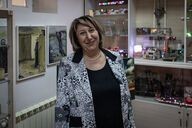
Armenia - Rebuilding after the war
Chris Huby / Le Pictorium
LePictorium_0272900.jpg
Armenia - Gyumri / Endanik - Portrait of the director of the centre.
The charitable NGO "Endanik" was founded in 1990 and was one of the first in Gyumri after the earthquake to deal with the basic problems of adolescents. Since the Azeri attacks at the end of 2020, the centre has been dealing with displaced persons and orphans
The charitable NGO "Endanik" was founded in 1990 and was one of the first in Gyumri after the earthquake to deal with the basic problems of adolescents. Since the Azeri attacks at the end of 2020, the centre has been dealing with displaced persons and orphans
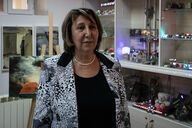
Armenia - Rebuilding after the war
Chris Huby / Le Pictorium
LePictorium_0272901.jpg
Armenia - Gyumri / Endanik - Portrait of the director of the centre.
The charitable NGO "Endanik" was founded in 1990 and was one of the first in Gyumri after the earthquake to deal with the basic problems of adolescents. Since the Azeri attacks at the end of 2020, the centre has been dealing with displaced persons and orphans
The charitable NGO "Endanik" was founded in 1990 and was one of the first in Gyumri after the earthquake to deal with the basic problems of adolescents. Since the Azeri attacks at the end of 2020, the centre has been dealing with displaced persons and orphans
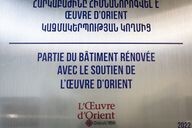
Armenia - Rebuilding after the war
Chris Huby / Le Pictorium
LePictorium_0272902.jpg
Armenia - Gyumri / A plaque from Endanik.
The charitable NGO "Endanik" was founded in 1990 and was one of the first in Gyumri after the earthquake to deal with the basic problems of adolescents. Since the Azeri attacks at the end of 2020, the centre has been dealing with displaced persons and orphans
The charitable NGO "Endanik" was founded in 1990 and was one of the first in Gyumri after the earthquake to deal with the basic problems of adolescents. Since the Azeri attacks at the end of 2020, the centre has been dealing with displaced persons and orphans

Armenia - Rebuilding after the war
Chris Huby / Le Pictorium
LePictorium_0272903.jpg
Armenia - Gyumri / Detail of an Endanik decoration.
The charitable NGO "Endanik" was founded in 1990 and was one of the first in Gyumri after the earthquake to deal with the basic problems of adolescents. Since the Azeri attacks at the end of 2020, the centre has been dealing with displaced persons and orphans
The charitable NGO "Endanik" was founded in 1990 and was one of the first in Gyumri after the earthquake to deal with the basic problems of adolescents. Since the Azeri attacks at the end of 2020, the centre has been dealing with displaced persons and orphans

Armenia - Rebuilding after the war
Chris Huby / Le Pictorium
LePictorium_0272904.jpg
Armenia - Gyumri / Arthur the director of Endanik shows a commemorative plaque of the entrance and on which one can see the various organizations which financed the center. Charitable NGO “Endanik” was founded in 1990 and was one of the first in Gyumri after the earthquake to deal with basic problems of teenagers. Since the Azeri attacks at the end of 2020, the center has been taking care of displaced persons and orphans
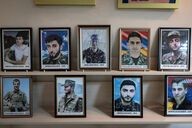
Armenia - Rebuilding after the war
Chris Huby / Le Pictorium
LePictorium_0272905.jpg
Armenia - Gyumri / At the entrance to Endanik, photos of former children who died during the 2020 44-day war - Founded in 1990 after the earthquake, this NGO was one of the first to deal teenagers in the region. Charitable NGO “Endanik” was founded in 1990 and was one of the first in Gyumri after the earthquake to deal with basic problems of teenagers. Since the Azeri attacks at the end of 2020, the center has been taking care of displaced persons and orphans

Armenia - Rebuilding after the war
Chris Huby / Le Pictorium
LePictorium_0272906.jpg
Armenia - Gyumri / The guestbook of Endanik in which one finds photos of the Work of the Orient during its passage through the centre.
The charitable NGO "Endanik" was founded in 1990 and was one of the first in Gyumri after the earthquake to deal with the basic problems of adolescents. Since the Azeri attacks at the end of 2020, the centre has been dealing with displaced persons and orphans
The charitable NGO "Endanik" was founded in 1990 and was one of the first in Gyumri after the earthquake to deal with the basic problems of adolescents. Since the Azeri attacks at the end of 2020, the centre has been dealing with displaced persons and orphans

Armenia - Rebuilding after the war
Chris Huby / Le Pictorium
LePictorium_0272907.jpg
Armenia - Gyumri / Endanik - Leatherwork classes are given to teenage girls.
The charitable NGO "Endanik" was founded in 1990 and was one of the first in Gyumri after the earthquake to deal with the basic problems of adolescents. Since the Azeri attacks at the end of 2020, the centre has been dealing with displaced persons and orphans
The charitable NGO "Endanik" was founded in 1990 and was one of the first in Gyumri after the earthquake to deal with the basic problems of adolescents. Since the Azeri attacks at the end of 2020, the centre has been dealing with displaced persons and orphans
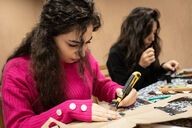
Armenia - Rebuilding after the war
Chris Huby / Le Pictorium
LePictorium_0272908.jpg
Armenia - Gyumri / Endanik - Leatherwork classes are given to teenage girls.
The charitable NGO "Endanik" was founded in 1990 and was one of the first in Gyumri after the earthquake to deal with the basic problems of adolescents. Since the Azeri attacks at the end of 2020, the centre has been dealing with displaced persons and orphans
The charitable NGO "Endanik" was founded in 1990 and was one of the first in Gyumri after the earthquake to deal with the basic problems of adolescents. Since the Azeri attacks at the end of 2020, the centre has been dealing with displaced persons and orphans

Armenia - Rebuilding after the war
Chris Huby / Le Pictorium
LePictorium_0272909.jpg
Armenia - Gyumri / Endanik - Leatherwork classes are given to teenage girls.
The charitable NGO "Endanik" was founded in 1990 and was one of the first in Gyumri after the earthquake to deal with the basic problems of adolescents. Since the Azeri attacks at the end of 2020, the centre has been dealing with displaced persons and orphans
The charitable NGO "Endanik" was founded in 1990 and was one of the first in Gyumri after the earthquake to deal with the basic problems of adolescents. Since the Azeri attacks at the end of 2020, the centre has been dealing with displaced persons and orphans
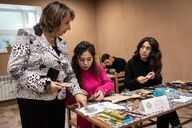
Armenia - Rebuilding after the war
Chris Huby / Le Pictorium
LePictorium_0272910.jpg
Armenia - Gyumri / Endanik - Under the eyes of the director, leatherwork classes are given to teenage girls.
The charitable NGO "Endanik" was founded in 1990 and was one of the first in Gyumri after the earthquake to deal with the basic problems of adolescents. Since the Azeri attacks at the end of 2020, the centre has been dealing with displaced persons and orphans
The charitable NGO "Endanik" was founded in 1990 and was one of the first in Gyumri after the earthquake to deal with the basic problems of adolescents. Since the Azeri attacks at the end of 2020, the centre has been dealing with displaced persons and orphans
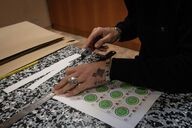
Armenia - Rebuilding after the war
Chris Huby / Le Pictorium
LePictorium_0272911.jpg
Armenia - Gyumri / Endanik - A teenager takes a decoration course.
The charitable NGO "Endanik" was founded in 1990 and was one of the first in Gyumri after the earthquake to deal with the basic problems of adolescents. Since the Azeri attacks at the end of 2020, the centre has been dealing with displaced persons and orphans
The charitable NGO "Endanik" was founded in 1990 and was one of the first in Gyumri after the earthquake to deal with the basic problems of adolescents. Since the Azeri attacks at the end of 2020, the centre has been dealing with displaced persons and orphans
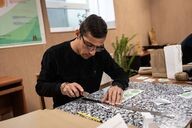
Armenia - Rebuilding after the war
Chris Huby / Le Pictorium
LePictorium_0272912.jpg
Armenia - Gyumri / Endanik - A teenager takes a decoration course.
The charitable NGO "Endanik" was founded in 1990 and was one of the first in Gyumri after the earthquake to deal with the basic problems of adolescents. Since the Azeri attacks at the end of 2020, the centre has been dealing with displaced persons and orphans
The charitable NGO "Endanik" was founded in 1990 and was one of the first in Gyumri after the earthquake to deal with the basic problems of adolescents. Since the Azeri attacks at the end of 2020, the centre has been dealing with displaced persons and orphans
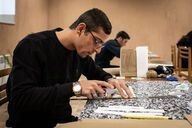
Armenia - Rebuilding after the war
Chris Huby / Le Pictorium
LePictorium_0272913.jpg
Armenia - Gyumri / Endanik - A teenager takes a decoration course.
The charitable NGO "Endanik" was founded in 1990 and was one of the first in Gyumri after the earthquake to deal with the basic problems of adolescents. Since the Azeri attacks at the end of 2020, the centre has been dealing with displaced persons and orphans
The charitable NGO "Endanik" was founded in 1990 and was one of the first in Gyumri after the earthquake to deal with the basic problems of adolescents. Since the Azeri attacks at the end of 2020, the centre has been dealing with displaced persons and orphans
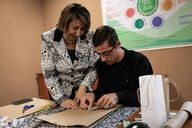
Armenia - Rebuilding after the war
Chris Huby / Le Pictorium
LePictorium_0272914.jpg
Armenia - Gyumri / Endanik - A teenager takes a decoration course.
The charitable NGO "Endanik" was founded in 1990 and was one of the first in Gyumri after the earthquake to deal with the basic problems of adolescents. Since the Azeri attacks at the end of 2020, the centre has been dealing with displaced persons and orphans
The charitable NGO "Endanik" was founded in 1990 and was one of the first in Gyumri after the earthquake to deal with the basic problems of adolescents. Since the Azeri attacks at the end of 2020, the centre has been dealing with displaced persons and orphans
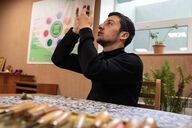
Armenia - Rebuilding after the war
Chris Huby / Le Pictorium
LePictorium_0272915.jpg
Armenia - Gyumri / Endanik - A teenager takes a jewellery course.
The charitable NGO "Endanik" was founded in 1990 and was one of the first in Gyumri after the earthquake to deal with the basic problems of adolescents. Since the Azeri attacks at the end of 2020, the centre has been dealing with displaced persons and orphans
The charitable NGO "Endanik" was founded in 1990 and was one of the first in Gyumri after the earthquake to deal with the basic problems of adolescents. Since the Azeri attacks at the end of 2020, the centre has been dealing with displaced persons and orphans
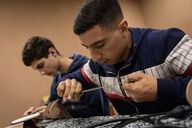
Armenia - Rebuilding after the war
Chris Huby / Le Pictorium
LePictorium_0272916.jpg
Armenia - Gyumri / Endanik - Teenagers attend jewellery classes.
The charitable NGO "Endanik" was founded in 1990 and was one of the first in Gyumri after the earthquake to deal with the basic problems of adolescents. Since the Azeri attacks at the end of 2020, the centre has been dealing with displaced persons and orphans
The charitable NGO "Endanik" was founded in 1990 and was one of the first in Gyumri after the earthquake to deal with the basic problems of adolescents. Since the Azeri attacks at the end of 2020, the centre has been dealing with displaced persons and orphans

Armenia - Rebuilding after the war
Chris Huby / Le Pictorium
LePictorium_0272917.jpg
Armenia - Gyumri / Endanik - Teenagers attend jewellery classes.
The charitable NGO "Endanik" was founded in 1990 and was one of the first in Gyumri after the earthquake to deal with the basic problems of adolescents. Since the Azeri attacks at the end of 2020, the centre has been dealing with displaced persons and orphans
The charitable NGO "Endanik" was founded in 1990 and was one of the first in Gyumri after the earthquake to deal with the basic problems of adolescents. Since the Azeri attacks at the end of 2020, the centre has been dealing with displaced persons and orphans
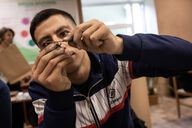
Armenia - Rebuilding after the war
Chris Huby / Le Pictorium
LePictorium_0272918.jpg
Armenia - Gyumri / Endanik - A teenager takes a jewellery course.
The charitable NGO "Endanik" was founded in 1990 and was one of the first in Gyumri after the earthquake to deal with the basic problems of adolescents. Since the Azeri attacks at the end of 2020, the centre has been dealing with displaced persons and orphans
The charitable NGO "Endanik" was founded in 1990 and was one of the first in Gyumri after the earthquake to deal with the basic problems of adolescents. Since the Azeri attacks at the end of 2020, the centre has been dealing with displaced persons and orphans
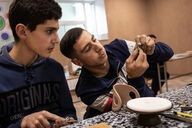
Armenia - Rebuilding after the war
Chris Huby / Le Pictorium
LePictorium_0272919.jpg
Armenia - Gyumri / Endanik - Teenagers attend jewellery classes.
The charitable NGO "Endanik" was founded in 1990 and was one of the first in Gyumri after the earthquake to deal with the basic problems of adolescents. Since the Azeri attacks at the end of 2020, the centre has been dealing with displaced persons and orphans
The charitable NGO "Endanik" was founded in 1990 and was one of the first in Gyumri after the earthquake to deal with the basic problems of adolescents. Since the Azeri attacks at the end of 2020, the centre has been dealing with displaced persons and orphans
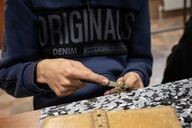
Armenia - Rebuilding after the war
Chris Huby / Le Pictorium
LePictorium_0272920.jpg
Armenia - Gyumri / Endanik - A teenager takes a jewellery course.
The charitable NGO "Endanik" was founded in 1990 and was one of the first in Gyumri after the earthquake to deal with the basic problems of adolescents. Since the Azeri attacks at the end of 2020, the centre has been dealing with displaced persons and orphans
The charitable NGO "Endanik" was founded in 1990 and was one of the first in Gyumri after the earthquake to deal with the basic problems of adolescents. Since the Azeri attacks at the end of 2020, the centre has been dealing with displaced persons and orphans
Next page
